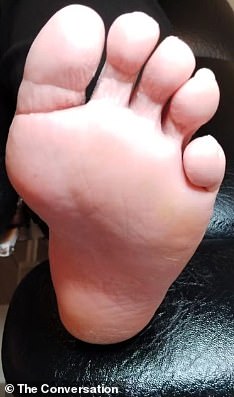You might not think it — but your feet can tell you a surprising amount about your health.
From pesky cracked heels and calluses to more serious problems, feet can often show signs of disease before other part of your body.
Now, experts have issued a warning alarm over a little known podiatric condition that — if left untreated — could cause blistering, thick crusty skin or even the loss of a toe altogether.
Known colloquially as an ‘Irish pinky toe’, the term describes a small, curved, or unusually shaped little toe that tucks beneath its neighbouring digit.
While the name suggests it’s more common in Ireland, the condition itself isn’t specific to any group and is often influenced by a combination of genetic and lifestyle factors.
According to podiatrists the position ‘Irish pinky toe’ can cause pressure on the neighbouring toe which in turn can lead to a number of problems.
‘If two bones or joints are pressed close together, this may cause the skin to thicken and result in a corn,’ Lauren Connell, a podiatrist and doctoral researcher and Benjamin Bullen, a lecturer in podiatric medicine at the University of Galway said.
‘Added pressure on the toe or toenail can also cause corns, calluses, thickened toenails and even ulcers that may lead to amputation,’ they wrote for The Conversation.


Known as an ‘Irish pinky toe’, the term is often used colloquially to describe a small, curved, or unusually shaped pinky toe (pictured left). Pictured right, the Irish pinky toe, thickened toenail, hard skin surrounding the nail and a corn

From pesky cracked heels and calluses to more serious problems, such as swelling, feet often show signs of disease before any other part of your body
Corns and calluses — thickened, hardened areas of skin — are one of the most common foot problems and develop when the skin tries to protect itself against friction or pressure and can prove painful.
Podiatrists are specialists trained to cut away calluses and corns painlessly with equipment such as blades, to reduce discomfort.
The ‘Irish pinky toe’ and its toenail may also rub up against the lining of shoes, leading to painful friction blisters or shoes that wear out quickly.
In some cases this can cause extra nail-like skin lesions to develop, so it looks like there the two has two nails.
There are, however, ways to protect the toe from such damage and take pressure off the area, the podiatrists advised.
They said tight footwear, such as boots with a steel toe cap or unforgiving court shoes should be avoided, given such footwear can force toes into unnatural positions over time.
‘Some people might throw on any old socks in the morning but ill-fitting socks can contribute to problem foot health,’ Ms Connell and Mr Bullen added.
‘Socks that do not stretch, or have heavy seams, may increase the pressure on your pinky toes.’

Podiatrists are specialists trained to cut away calluses and corns painlessly with equipment such as blades, to reduce discomfort
Instead they advised that higher quality, breathable fabrics such as cotton or bamboo, may help protect the toe.
‘If you have to wear specific safety footwear for your job, such as in farming and construction, you may find higher quality, thicker socks are better than boots with thick fabrics in the toe,’ they said.
This is because they are more likely to wear down over time.
Podiatrists are also able to ‘prep’ the toe by making supports such as insoles to lift the toes off the ground, separate tight toes or improve the toe’s position, to avoid future problems.
The NHS also advises patients to visit their pharmacy for advice on heel pads, insoles and pain relief to help manage calluses.
This article was originally published by a www.dailymail.co.uk . Read the Original article here. .


